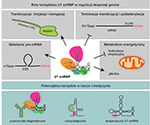The role of the U1 snRNP complex in the regulation of gene expression: recent reports
DOI:
https://doi.org/10.18388/pb.2021_566Abstract
U1 snRNP (U1 small nuclear ribonucleoprotein) is a nuclear ribonucleoprotein complex involved mainly in pre-mRNA splicing, which is a key regulatory process in the eukaryotic gene expression pathway, but also in the process of preventing premature transcription termination (telescripting). U1 snRNP interacts directly with RNA polymerase II, thereby influencing the synthesis and maturation of transcripts in the cell nucleus, including the formation of the 3' end of mRNA and polyadenylation. At the level of cell physiology, it regulates the functioning of mitochondria and energy metabolism. The core of the U1 snRNP complex is U1 snRNA, encoded by many copies of genes that differ in sequence and expression level, and the expression of some of them leads to the formation of defective products. According to current reports, U1 snRNA can be used for therapeutic purposes to regulate gene expression and improve mRNA splicing defects, which are the cause of many diseases. Here we present selected recent discoveries and achievements related to U1 snRNP.

Published
Issue
Section
License
Copyright (c) 2024 Mikołaj Kiraga, Monika Zakrzewska-Płaczek

This work is licensed under a Creative Commons Attribution 4.0 International License.
All journal contents are distributed under the Creative Commons Attribution-ShareAlike 4.0 International (CC BY-SA 4.0) license. Everybody may use the content following terms: Attribution — You must give appropriate credit, provide a link to the license, and indicate if changes were made, ShareAlike — If you remix, transform, or build upon the material, you must distribute your contributions under the same license as the original. There are no additional restrictions — You may not apply legal terms or technological measures that legally restrict others from doing anything the license permits.
Copyright for all published papers © stays with the authors.
Copyright for the journal: © Polish Biochemical Society.



